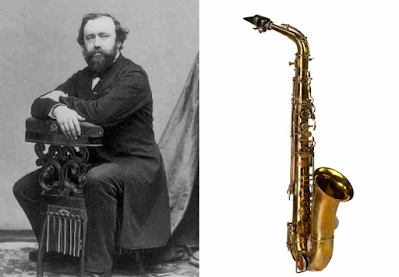Adolphe Sax
Birth Name: Antoine-Joseph "Adolphe" Sax
Born: November 6, 1814 in Belgium
Died: February 4, 1894, age 79, in Paris France
Adolphe Sax was the oldest of 11 children. His father Charles Joseph Sax and his mother Marie Joseph (Masson) Sax were both instrument designers. Charles Sax was locally known for changing the design of the French Horn and although he enjoyed a good reputation, he didn't reach the level of acclaim as his son. He blamed it on having to support his family and stayed with designing and selling more conventional instruments.
Adolphe apprenticed under his father, experimented with new designs and made several instruments. At age 15, he began entering his instruments in competitions which encouraged him to attend the Royal Conservatory of Brussels, learning to improve the performance of his instruments.
At the age of 20, Adolphe designed a 24-key bass clarinet, a unique instrument that had never been made before. This caught the attention and admiration of the conductor of the Paris Opera Orchestra, Francois Antoine Habeneck, who was stationed in Brussels at the time.
But the recognition wasn't enough for Adolphe; he wanted international fame and more recognition. He left Brussels and moved to Paris, the center of the arts in Europe, and began working on saxhorns, sort of a smaller version of the tuba, and they became very successful. He made them in seven different sizes and these later influenced the creation of the flugelhorn.
In 1839 at age 24, he obtained his first patent but it was not for his own invention. It was for an improvement on the design of the bass clarinet.
The popularity of his saxhorns spread through the music community but he still did not have a patent for the instrument. This became important at the Paris Industrial Exhibition in 1844, when a German man named Wieprecht accused him of stealing the idea from the Germans.
Adolphe had to defend himself in a public showdown held in the German city of Koblenz. This event was attended by famous musicians and composers, especially composer Franz Liszt. The claim was that Wieprecht and others were already familiar with the saxophone and bass clarinet because these instruments had been invented by Germans earlier. However, when they were asked to play them, they could hardly do so and Adolphe's name was cleared.
He put his efforts into the valved bugles which were state of the art at that time and are pretty much the same today. Adolphe's successful designs later influenced the British Bass Band Movement which exclusively used the saxhorn family of instruments.
On June 28, 1846, he finally obtained a patent for the saxophone ranging from soprano to subcontrabass. He intended them to be used in orchestras and military bands but he didn't get the support for their inclusion until the mid-1850's.
He received critical acclaim from other composers and began to manufacture his saxophone as special orders in different sizes. Many composers began writing parts in their symphonies for the saxophone.
His reputation was well known all over Europe but especially in France. which helped him to acquire a position teaching a new saxophone course at the Paris Conservatory in 1857.
He continued to make instruments but he was plagued with legal troubles for his patents.Rival instrument makers attacked the legitimacy of his patents and he was forced to sue them three different times for patent infringement. This was very expensive and drove him into bankruptcy in 1852, 1873, and 1877.
He was saved from filing a fourth bankruptcy by one of his admirers, the Emperor Napoleon III.
From 1853 to 1858, he suffered from lip cancer but was cured by a herbalist. He never married but he had 5 children by a Spanish mistress. One of his sons took over his instrument business after his death.
During his lifetime, Adolphe Sax was disappointed to see that his invention had not caught on in classical music. But it was mostly used in military bands. His dream was realized after his death because the saxophone is now an essential part of classical music, particularly in the United States.
He died in poverty in Paris, France on February 7, 1894 and was buried in the Montmarte Cemetery in Paris.
You are here:
https://inventionsandpatents.blogspot.com
https://inventionsandpatents.blogspot.com

No comments:
Post a Comment